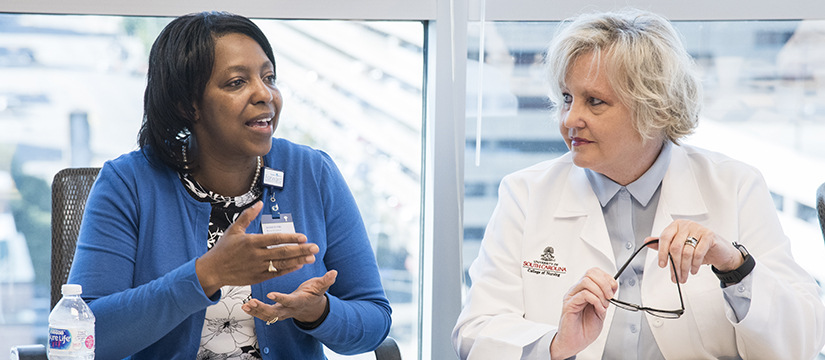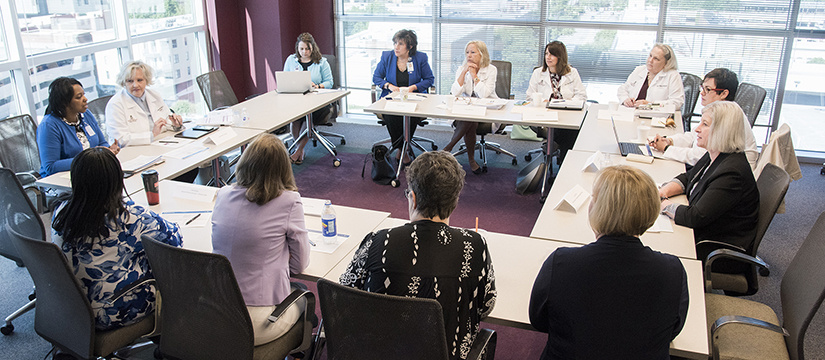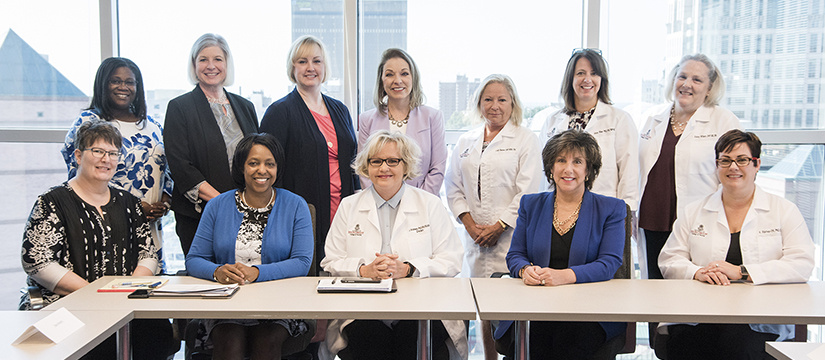It was hardly the beginning Jeannette Andrews envisioned. Early in her tenure as dean
of the College of Nursing, she made the tough call to temporarily shrink the Bachelor
of Nursing class because there were too few clinical preceptors to teach students.
Across town, Carolyn Swinton, ’91, then the chief nursing officer for Palmetto Health, sympathized but was grappling
with her own shortage of bedside nurses as experienced staff left to pursue advanced
practice degrees. But as the nurse leaders’ relationship developed, both grew to realize
their institutions would be stronger if they worked together to tackle the mounting
challenges in health care education and delivery.
A New Vision for Collaboration
For more than 50 years, the college and health system have worked together to educate
nurses. On any given day, 250 to 300 Carolina nursing students participate in clinical
rotations across the Palmetto Health system, which provides about 70 percent of the
college’s clinical site placements. The organizations had also historically partnered
by sharing expert nurses as clinical adjunct faculty, co-sponsoring vents and conducting
faculty research.
In 2015, as Andrews and Swinton started brainstorming how to make their partnership more intentional and more fruitful, their counterparts in medicine took steps to create the Palmetto Health–USC Medical Group, the region’s largest, joint multispecialty medical group.
Alongside the release of the 2016 Manatt Health/American Association of Colleges of Nursing report “Advancing Healthcare Transformation: A New Era for Academic Nursing,” the conversation between Swinton and Andrews sparked a commitment to jointly address strategic priorities and strengthen the profession’s visibility across the state.
“We have a shared vision, and that vision is to speak with one voice of nursing to ensure that nurses show up strong in our communities and secure the future of nursing.”
Carolyn Swinton, chief nursing executive for the South Carolina Health Company, Palmetto Health’s parent organization
The partnership coalesced around three challenges, each governed by a separate charter and team of college faculty members and hospital nurses, as well as leaders from each entity.
Challenge 1: Enhance BSN graduate readiness for practice
Before the charter was formed, the College of Nursing and Palmetto Health both sought
to bolster new-graduate readiness but did so in isolation, looking only at their own
curriculum and learning activities, Andrews says. As a result of the partnership,
however, they are mapping nurse education across a continuum that begins with acceptance
into the College of Nursing and spans the first few years of practice at Palmetto
Health, examining learning opportunities at each institution. This comprehensive,
holistic approach eliminates redundancy, identifies gaps and sequentially builds skills
on a deeper level rather than function-ing as two separate, parallel tracks.
Based on feedback from the charter committee, Palmetto Health designed a series of nursing support roles that students can begin upon acceptance into the college, increasing their experience with patient care and nursing workflow, Swinton says.
“The more contact and interaction you have in the patient-care area, you build your
confidence, you build your skills,” she says.
Other highlights from the first charter include: real-time feedback between hospital
staff nurses and faculty members about the curriculum, higher-intensity simulation
scenarios that better reflect the demands on bedside nurses, and a clinical prac-tice
specialist role at Palmetto Health, filled by a clinical faculty member who rounds
on recent graduates one or two evenings per week, building on the relationship as
their former student preceptor.
Challenge 2: Increase Palmetto Health’s registered nurse workforce
To combat a shortage of bedside nurses, Palmetto Health strives to be a destination
employer for recent graduates.
Through the charter, the health system has developed a red-carpet program to attract
new nurses, leveraging its competitive residency program to retain top graduates.
University of South Carolina BSN students are given priority in the program, Swinton
says. Because of the curricular alignment, Carolina nursing students can bypass the
program’s orientation, allowing them to spend more time in their preferred unit.
During the residency, students are introduced to key resources and personnel, such as physicians, respiratory therapists, pharmacists, lab technicians and physical therapists. Palmetto Health is intentionally fostering these relationships to help students transition and integrate into the care team, Swinton says.
The number of USC nursing students participating in the residency program has steadily
grown from 21 in 2015
to 47 in 2017. Moreover, the two-year retention rate of those Carolina graduates is
95 percent.
Other highlights from the second charter include: clinical rotations de-signed by faculty and hospital nurses who help staff the roles, a cohesive, singular preceptor education system between the institutions, yielding a seamless experience for students, recent graduates and preceptors, real-time feedback about student experi-ences on units, and tuition assistance for students who work in a health system support role during nursing school.
Challenge 3: Advance big data use to cut 30-day hospital readmissions
As payers demand a reduction in 30-day readmissions by cutting funds for those hospitalizations,
Palmetto Health is turning to data-driven best practice implementation as a solution.
Through the third charter, the college shares faculty expertise in big data. Associate
professor Ronda Hughes serves on the health system’s informatics committee, which allows her to offer insight
about which data should be collected to advance the health system’s goals. In addition,
Hughes helps Palmetto Health with other projects, such as measuring the return on
investment in the residency program.
Building on Synergies
Buoyed by the success of the three charters, key leaders from each institution gathered
in May to discuss next steps for the partnership.
Creating an expert bedside practice role — and a master’s-level program to support it — is an area of interest, as is analyzing patient-care transitions to develop data-driven solutions for improved care outcomes.
“Five years ago, we wouldn’t have done this,” Andrews says. “Our partnership is really the cutting-edge of how to synergistically advance the education and practice of nursing for the future.”
By working more closely, the organizations are realizing their shared vision for preparing the nurses of the future and empowering them to practice at the top of their license in an ever-changing health care environment.
“A significant point in forming the partnership is to answer the question: Is it possible to achieve staffing adequacy, develop expert clinicians and maintain a strong voice for our profession given the current and future challenges we face with the nursing shortage?” Swinton says. “The answer is yes — because the commitment of strong partners makes it so. We have the skill and the talent to get the job done.”


